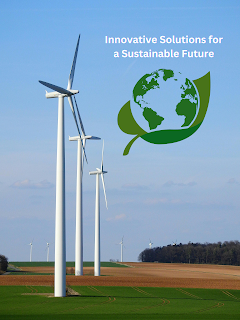introduction
As
the world grapples with the pressing challenges of climate change, resource
depletion, and environmental degradation, the need for innovative solutions has
never been more urgent. Sustainable development aims to meet the needs of the
present without compromising the ability of future generations to meet their
own needs. This article explores some of the most promising innovative
solutions across various sectors, including energy, agriculture, waste
management, and urban planning, highlighting how these advancements can
contribute to a more sustainable future.
Renewable Energy Technologies
One
of the most significant contributors to climate change is the reliance on
fossil fuels for energy. Transitioning to renewable energy sources is crucial
for reducing greenhouse gas emissions. Innovations in solar, wind, and
hydroelectric power have made these technologies more efficient and affordable.
Solar Energy
Photovoltaic
(PV) cells have seen dramatic improvements in efficiency and cost over the past
decade. Advances in materials science, such as the development of perovskite
solar cells, promise even higher efficiency rates and lower production costs.
Additionally, innovative applications like solar paint and solar windows are
expanding the potential for solar energy integration into everyday life.
Wind Energy
Wind
energy technology has also advanced significantly. The development of larger,
more efficient turbines, coupled with floating wind farms, allows for energy
generation in deeper waters where wind speeds are typically higher. Offshore
wind farms can generate significant amounts of clean energy while minimizing
land use conflicts.
Energy Storage
One
of the biggest challenges with renewable energy is its intermittent nature.
Innovative battery technologies, such as lithium-sulfur and solid-state
batteries, are being developed to improve energy storage capabilities. These
advancements can store excess energy generated during peak production times for
use when demand is higher, stabilizing the energy grid and enhancing
reliability.
Sustainable Agriculture
Agriculture
is both a major contributor to greenhouse gas emissions and a sector highly
vulnerable to climate change. Innovative farming practices can help mitigate
these effects while ensuring food security for a growing global population.
Regenerative Agriculture
Regenerative
agriculture focuses on restoring soil health, increasing biodiversity, and
enhancing ecosystem services. Techniques such as cover cropping, crop rotation,
and agroforestry not only sequester carbon but also improve resilience to
extreme weather events. Farmers adopting these practices report improved yields
and reduced input costs over time.
Vertical Farming
As
urban populations grow, the need for efficient food production systems becomes
critical. Vertical farming utilizes controlled environments to grow crops in
stacked layers, minimizing land use and water consumption. This method reduces
transportation costs and emissions by allowing food to be grown closer to urban
centers, ensuring fresher produce and enhancing food security.
Biotechnology
Advancements
in biotechnology, such as CRISPR gene editing, hold great potential for
developing crops that are more resilient to pests, diseases, and climate
variations. By enhancing the genetic traits of crops, farmers can achieve
higher yields with fewer inputs, thereby reducing the environmental impact of
agriculture.
Waste Management Innovations
The
linear model of “take, make, dispose” is increasingly being replaced by a
circular economy that emphasizes waste reduction, recycling, and resource
recovery. Innovative waste management solutions are essential for minimizing
landfill use and reducing pollution.
Waste-to-Energy Technologies
Waste-to-energy
(WTE) technologies convert non-recyclable waste materials into usable heat,
electricity, or fuel through various processes, including combustion,
gasification, and anaerobic digestion. These technologies not only reduce the
volume of waste sent to landfills but also provide a renewable source of energy,
contributing to a more sustainable waste management strategy.
Plastic Alternatives
The
environmental impact of plastic waste is profound, leading to widespread
pollution and harm to wildlife. Innovations in biodegradable materials, such as
plant-based plastics and mycelium packaging, offer promising alternatives to
traditional plastics. These materials break down more quickly in natural
environments, significantly reducing long-term pollution.
Smart Waste Management
The
integration of technology in waste management systems can optimize collection
routes, improve recycling rates, and reduce operational costs. Smart bins
equipped with sensors can monitor waste levels in real-time, enabling
municipalities to manage resources more efficiently and reduce carbon footprints.
Urban Planning and Sustainable Development
Urban
areas are responsible for a significant portion of global greenhouse gas
emissions. Innovative urban planning and sustainable development strategies are
essential for creating livable, resilient cities.
Green Architecture
Sustainable
building practices emphasize energy efficiency, resource conservation, and
indoor environmental quality. Innovations such as green roofs, energy-efficient
HVAC systems, and sustainable materials contribute to reduced energy
consumption and a lower carbon footprint. Additionally, net-zero energy
buildings produce as much energy as they consume, significantly reducing
reliance on fossil fuels.
Smart Cities
The
concept of smart cities integrates information and communication technologies
to improve urban infrastructure and enhance the quality of life for residents.
Smart grids, efficient public transportation systems, and intelligent waste
management solutions can reduce energy consumption and promote sustainable
practices among citizens.
Urban Green Spaces
Integrating
green spaces into urban environments provides numerous benefits, including
improved air quality, reduced urban heat islands, and enhanced mental
well-being. Innovative approaches, such as urban forestry and community
gardens, foster biodiversity and promote community engagement, creating
healthier and more sustainable urban ecosystems.
Final Thought
Innovative
solutions for a sustainable future are not just a distant dream; they are
increasingly becoming a reality. By leveraging advancements in technology,
science, and sustainable practices across various sectors, we can address the
environmental challenges of our time. Collaboration among governments,
businesses, and communities is essential to implement these solutions
effectively and create a more sustainable world for future generations.
Embracing innovation today can pave the way for a thriving planet tomorrow.















.png)
0 Comments